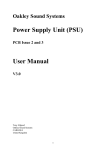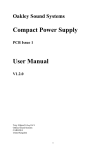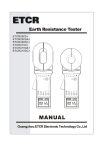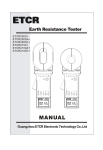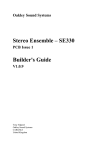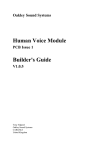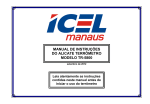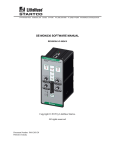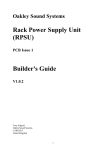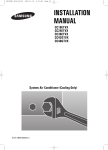Download User Manual - Oakley Sound Systems
Transcript
Oakley Sound Systems Rack Power Supply Unit (RPSU) PCB Issue 1 User Manual V1.0.2 Tony Allgood Oakley Sound Systems CARLISLE United Kingdom 1 Introduction This is the User Manual for issue 1 of the RPSU circuit board from Oakley Sound. The Oakley RPSU is a power supply unit designed to be used in conjunction with the Oakley rack projects like the HVM and SE330. However, it may also be used with a Dizzy module as part of a larger DIY project. As well as giving details as to what the PSU board does, this document contains instructions on how to wire up your board to your source of power, any external switches and the optional power indicator. I will also give you some information about suitable sources for your low voltage AC power supply. The Oakley PSU allows for various options in the installation. You can use the unit either in full wave rectification mode for connection to tapped linelumps or twin transformer secondaries, or in half wave rectification for single phase AC output wallwarts and linelumps. If all this sounds very confusing at the moment, do not worry, in this manual I will try to make it clearer so that you make the right decision about what power source you will need. If you are building the RPSU as a complete DIY project please also download the latest Builder's Guide. This can be found on the main RPSU webpage along with our very useful generic parts and construction guides. 2 Safety Warning This supply has been designed to work with isolated low voltage AC inputs only. Connection to any alternating current supply is done at your own risk. Low voltage is classified as being less than 25V with respect to the ground potential. Voltages above this level can, and often are, lethal to living creatures. Oakley Sound Systems will not advise on building or modifying this board to allow for direct connection to the mains, or other high voltage sources, further to what is provided in this document. Please do not ask us for additional information pertaining to direct mains connections or using internally mounted transformers as we will not give it. For safety and legal reasons we cannot recommend powering this board from any other supply than low voltage AC output mains adapters. Oakley Sound Systems are not liable for any damages caused by the misuse of this product. It is your responsibility to use this product safely. If you have any doubt about installing a safe power supply, then please do not attempt to do so. 3 The Oakley RPSU module This power supply board will allow the conversion of a suitable low voltage alternating current (AC) to be rectified, smoothed and regulated. The module is designed to be fitted to a suitably large metal panel which functions as a heatsink for the two regulator devices attached to the RPSU circuit board. The metal panel should have adequate airflow around it and it is expected that it will be part of the metal enclosure your rack project is built into. It is possible, if the RPSU is only powering a small amount of electronics, that the unit can be used with either no heatsinks or just small clip-on types. However, it is up to the builder to determine whether or not this is possible. If in operation the two power devices get too warm to touch for more than ten seconds you will need additional heatsinking. If the RPSU is powering just one HVM it will need heatsinking. The voltage output of the power supply module is a split rail 15V supply. This means it generates both +15V and -15V. That is, two power rails, one of a positive voltage, the other a negative one. These voltages are measured with respect to a common ground which is normally connected, via your house's wiring, to the earth that you stand on. The voltage across both rails is 30V, with the common ground sitting exactly in the middle of this at 0V. The output current capability is the maximum current you can draw out of the power supply. The current taken from the supply is determined by the amount and type of modules you are connecting to the power supply. One HVM will draw around 80mA from the +15V supply and 80mA from the -15V supply. The Oakley RPSU features current limiting but only what is built into the two power devices. Although this will probably stop your project from bursting into flames it is not to be relied on if the fault continues for a long period of time. The RPSU is fitted with fuses and the correct choice of fuse will probably save your project in the event of a major breakdown. If you are using a single phase 500mA (or 0.5A) AC wallwart* then the most current you can take from this power supply module is around 125mA from each rail. This is enough to drive one HVM. You may think that a 500mA power pack should be able to drive up to 250mA for each rail. But simple arithmetic does not work when you are dealing with conversion from AC to DC. The various parts of the power supply require power to work and this reduces the useful power we can actually draw from the supply. The rule of thumb is that the AC current drawn is roughly 1.8 times that of the DC current drawn. This means we can take 278mA from both supplies, that is 139mA for each rail. To allow for some safety margin we drop this down to 125mA per rail which allows for a 10% overhead. This is plenty enough for one HVM but not much else. Various companies make wallwarts* and linelumps** with a greater capacity than 500mA. If you can get a 1A output one than this will be able to drive up to 250mA per rail. With any single phase supply you will be using your RPSU in half wave rectification mode. Single phase mains adapters are the most common and have only two wires coming from them. They are normally connected to the rack with a barrel type plug. 4 Some linelumps, like the Yamaha PA-20 and PA-30, use a split AC output or a centre tapped AC output. This means it has three wires coming from it and will use a different plug from the usual round barrel one you see on the single phase AC wallwarts. With a split AC output the Oakley RPSU should be wired to work in full wave rectification mode. The Yamaha PA-20 supply is rated to give an output voltage of 35Vac (with a centre tap) at a load of 0.94A. Once rectified and smoothed this means that a maximum current of 0.52A per rail can be drawn from the RPSU. This is plenty enough to drive the HVM and an SE330. Two sets of screw terminal blocks are provided for connecting the low voltage AC power source to the board and the optional power switch. If you are using a single phase wallwart to power the RPSU module than you need only to use two terminals per terminal block. The board has four mounting holes for stable placement onto your modular case. Care should be taken so that the board's various board mounted components do not come into contact with any part of the enclosure. One of the mounting holes, the top right hand one, is connected to the ground point of the RPSU via a 'resistor', R5. In most situations R5 will be a low value resistor but see later for more details on this. The power supply has two integral fuse holders in case of a problem with the power supply circuitry itself. Two fuses are needed if you are using full wave rectification, but only one, F2, is required for half wave rectification. The fuse type should be a slow blow or anti-surge type. The size is 20mm. It should be rated at between one and two times the maximum current of your wallwart. Thus a 500mA AC output mains adapter should have a fuse that is rated between 500mA and 1A, ideally 750mA. A 1A linelump should have a fuse that is between 1A and 2A, ideally 1.5A. There is one LED indicator for the AC input. This can be built onto the board, fitted to the front panel or omitted altogether. Both the HVM and SE330 modules have power on indicator LEDs. However, the RPSU's LED will light as soon as AC power is applied and not just when the unit is switched on. As we have seen the standard circuit provides two outputs, one at +15V and one at -15V. Both output voltages can be finely adjusted with its own trimmer. Unlike some power supplies the -15V rail will not track the +15V. The RPSU contains two separate, but complementary, power supplies. The output voltages are available from two 3.96mm Molex KK or MTA headers. * A wallwart is the vernacular term for a low voltage mains adapter that plugs directly into the wall. These take the form of a black plastic block that is shaped like an oversized mains plug. It is called a wart simply because its appearance is somewhat uglier than a normal slimline plug. ** A linelump does the same job as a wallwart but it generally can handle greater currents. Because of its increased size it cannot be made so that it will safely fit into a plug socket directly. Thus the adapter sits in a black plastic box and connects to the wall via a cable and traditional mains plug. It is therefore a black plastic lump connected to a line. The Yamaha PA-20 and PA-30 are such linelumps. 5 The Power Supply to the Power Supply The standard method of powering the unit is from a low voltage tapped AC source. The safest available option is to use a ready made 'wallwart' or ‘line lump’ supply. You can use any 15V or 18V AC output wallwart of linelump you can source. The current capability of the mains adapter, sometimes incorrectly called the 'ampage', will determine the maximum current draw of your PSU. Maplin N58AT This is a 1000mA single phase AC output wallwart. It is a variable output type. This means it has a little selector switch on the underside of the unit that allows you to change the output voltage. You should select 15V for operation with the RPSU board. I do not recommend you take more than 250mA per rail. Because this is a single phase unit the Oakley PSU is wired in half-wave rectification mode. You notice that only two wires come out of the wallwart and that you can select from a variety of output socket types. Simply chose the one you would like to use on your system and buy the appropriate socket for it to go into. I tend to recommend the 2.5mm DC power plug one since this is the most common type of power socket. You should fit fuse F2 only and it should be an anti-surge type and rated between 1.5A and 2A. 6 Yamaha PA-20 This is a linelump supply and features a fixed 17.5-0-17.5 volt AC output at 0.94A maximum. This means it gives us two AC outputs with a centre tap or mid point reference voltage. So unlike the single phase AC adapter output with two leads, this one has three. This means you need to use the Oakley RPSU in full wave rectification mode. The PA-20 is made for Yamaha products and they are available from Yamaha spares departments as well as many music shops, eg. Thomann. These are CE approved and connect to the mains via your local mains connector. They will be different types depending on the country you need them for. It comes with a handy three way plug at the low voltage end that you can use with an appropriate socket. If you wish you can ditch their connector and use your own. Maplin in the UK sell a suitable three way connector to fit the Yamaha one perfectly. Their part number is FM51F. In the UK the line lump’s part number is V9812300 and the total cost is around £35 including VAT and postage. If you are buying these direct from Yamaha and, for some reason, are asked why, the probably best thing is to say it is for a MG12/4 mixer. Once rectified, smoothed and regulated the Yamaha PA-20 can deliver up to 0.52A continuously into both 15V rails. You should fit both fuses and both should be anti-surge types and rated between 1A and 1.6A. The European version of the PA-20. Other country's units are similar but will have the local mains connector fitted. If you have successfully used the Oakley PSU with any other types of power pack please do let the community know via the Oakley Sound forum at www.muffwiggler.com 7 Linelumps and Wallwarts: Wiring Diagrams Input wiring will depend on the type of wallwart or linelump you will be using. Standard AC output wallwart Single phase, two wire, wallwarts or linelumps need to use half wave rectification so the Oakley PSU can generate both positive and negative supplies simultaneously. They only need the terminal's AC1 and 0V2 wired to the power socket. AC2 and 0V1 are left unused. Wallwart with single phase AC output, eg. Maplin N58AT The front panel switch is a single pole single throw (SPST) switch which simply connects S1R and S1S together when switched on. You can replace the switch with a simple wire link, but I do recommend that a switch be fitted so the socket doesn't have to take the full surge current when you insert it with the wallwart powered up. I also recommend fitting the AC indicator LED too. This is so you know the wallwart or linelump is on. The AC indicator is designed to indicate the status of incoming power and is not determined by the position of the standby switch. The standby switch should not be used to turn the unit off permanently. This should be done by either switching the adapter off at the mains socket, or by pulling the adapter's plug out of the mains socket. R5 should be fitted and is a 47R, 1/4W resistor. 8 Centre tapped wallwarts and linelumps Centre tapped linelumps like the Yamaha PA-20 will have three wires coming from their connector. It will have two AC outputs and one 0V. Take one of the AC outputs to terminal AC1 and the other AC output to terminal AC2. It should not matter which AC output goes to AC1 or AC2. The 0V should go to the 0V2 terminal. The 0V1 terminal is left unused. Figure 2. Linelump wiring with centre tapped output, eg. Yamaha PA-20 The front panel switch is a double pole single throw (DPST) switch which connects S2R and S2S together, and S1R and S1S together, when switched on. You can replace the switch with two wire links, but I do recommend that a switch be fitted so the socket doesn't have to take the full surge current when you insert it if the linelump is powered up. I also recommend fitting the AC indicator LED too. This is so you know the linelump is on. The AC indicator is designed to indicate the status of incoming power and is not determined by the position of the standby switch. The standby switch should not be used to turn the unit off permanently. This should be done by either switching the adapter off at the mains socket, or by pulling the adapter's plug out of the mains socket. R5 should be fitted and is a 47R, 1/4W resistor. 9 Using an Internal Mains transformer Be afraid, be very afraid... Some of you old hands will laugh about the level of hysteria that surrounds direct mains connection to DIY projects. However, this fear is more to do with our litigious society than the real danger to the builder. Even so, I have had more than my fair share of high voltage shocks over the years and it is not something I would want any builder to have to experience. It has been purely luck that has saved me in several of those cases. So I will say again – do not attempt to build a mains transformer into your case, or any other project, without realising that to do so carries a risk of death to either you, or to the person who may inadvertently put their fingers into your half built construction. Furthermore, it is up to you as the builder of such an item to make sure, that once built, the item is safe to use and meets all current safety legislation. This is not a complete set of instructions on how to fit a transformer into a piece of electronic equipment. This information is offered only as a guide and should not be considered as your only source of information. No further information, other than that included here, will be provided by myself or Paul Darlow regarding the construction of mains powered items. For powering a HVM and an SE330 together then the mains transformer's secondaries should be rated: 18-0, 18-0 (or 18-0-18) 30VA This will give you a power supply that should be theoretically capable of providing just over 400mA to each rail assuming your heatsink and smoothing capacitors are up to the job. The transformer secondary voltage is suggested to be 18V. It may be possible to use a transformer rated at 15V. Most transformers produce more than their stated voltage when drawing less than their maximum current and I have found that 15V toroids always work well here in the UK. The benefit of using a lower secondary voltage is cooler power devices. However, the disadvantage is that you may be running your power supply very close to its lowest operating voltage – particularly if your country's line voltage is less than the expected 230V (or 110V). Slightly higher transformer secondary voltages can also be tolerated although you need to consider three things: 1. You may need a physically larger transformer for the same output power. 2. The power supply's components, including the smoothing capacitors, should be rated at a high enough working voltage to handle the increased voltage across them. 10 3. The heatsink will need to dissipate even more energy because of the greater voltage drop across the regulators. In the wiring diagram shown I have included a suggested wiring method for connecting up a mains transformer. Not all mains transformers are the same, some have additional windings, others have tapped windings. I have simply used a single primary, double secondary type for example only. For the mains fuse you should use a 500mA anti-surge type. All wiring at mains potential should be adequately insulated and protected from straying fingers. There is no need to fit an AC standby switch since you will be fitting a proper mains power on switch in series with the transformer primary coil. So you should link S1A to S1R, and S2S to S2S, on the PCB. Earthing Remember it is up to you, the builder of the equipment, to make sure that your item is safe and is built to the required safety standard in your country. These notes are only a guidance and it is up to the reader to establish the exact obligations required in their own country. It is essential that everything you build, that has both live mains inside and a metal case or panels, has a safety earth fitted. UK legislation says that any metal panelling should be adequately insulated, ie. double insulated, or connected to earth. Since making a double insulated case is not practical you should ensure that any exposed external metal parts be properly earthed. The case should be bonded to earth using an M4 screw, toothed washer, washer, solder tag and a securing nut (or two) bolted through the case and then via a thick piece of wire back to the earth tang of the IEC power inlet. Remember that all parts of the case must be earthed too. Painted metal parts of the case must be dealt with so that they too are earthed. This may involve using secondary bonding points or scraping back the paint at the appropriate point. The RPSU board should be securely mounted (using all four mounting holes) onto the earthed casing using appropriate screws and toothed washers. R5 on the power supply board should be a wire link. This should ensure that the power supply ground (0V) is tied to earth. You will also need to provide earthing to any exposed transformer core. This does not apply to toroidal types but EI types should have their metal frame earthed. It is possible that by earthing the case and local ground you may introduce earth loops when you connect your mixer to the sockets of your project. The outcome of this is audible humming at 50/60Hz and its harmonics. It is produced by earth currents travelling down the screen of the connecting cable(s). This can be avoided by careful studio wiring and/or by using balanced audio lines to pipe signals to and from the module and mixing desk. Most mixing desks and sound cards will have balanced outputs and inputs. 11 Mains wiring diagram. For experienced builders only! 12 Final Comments I hope you that the Oakley RPSU lives up to your expectations and provides you with a reliable source of power for your project. If you have any questions about the module, an excellent source of support is the Oakley Sound Forum at Muffwiggler.com. Paul Darlow and I are on this group, as well as many other users and builders of Oakley modules. If you have a comment about this user manual, or have a found a mistake in it, then please do let me know. Last but not least, can I say a big thank you to all of you who have helped and inspired me over the years. Thanks especially to all those nice people at Muff's and the Synth-DIY and Analogue Heaven mailing lists. Tony Allgood at Oakley Sound Cumbria, UK © March 2013 – updated May 2014 13













